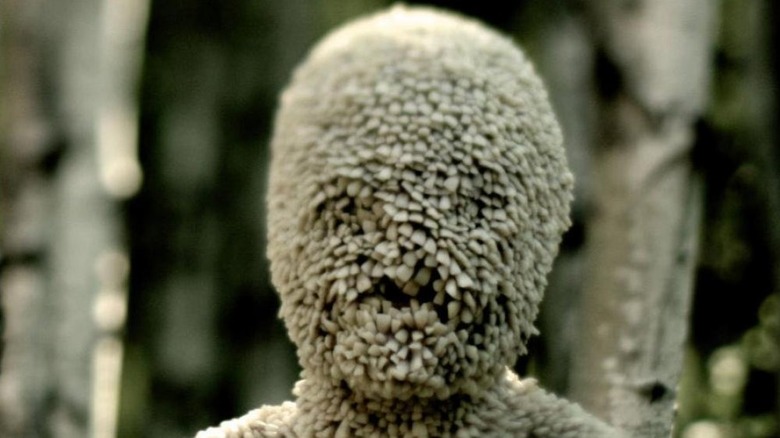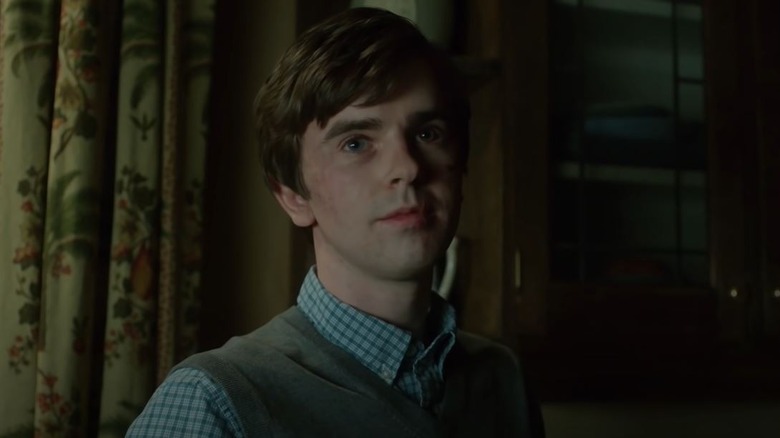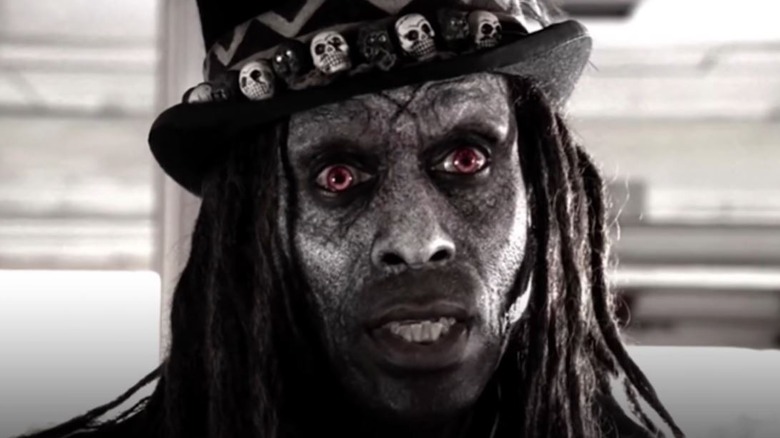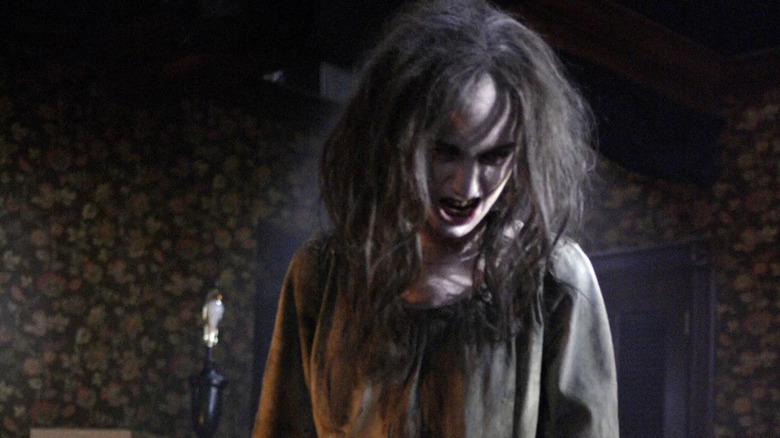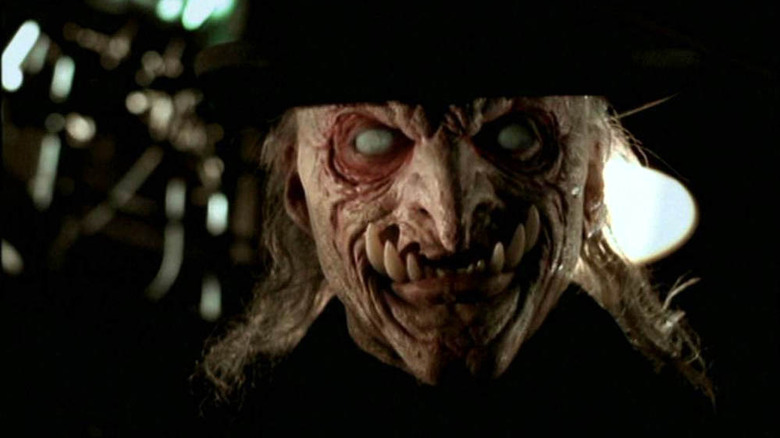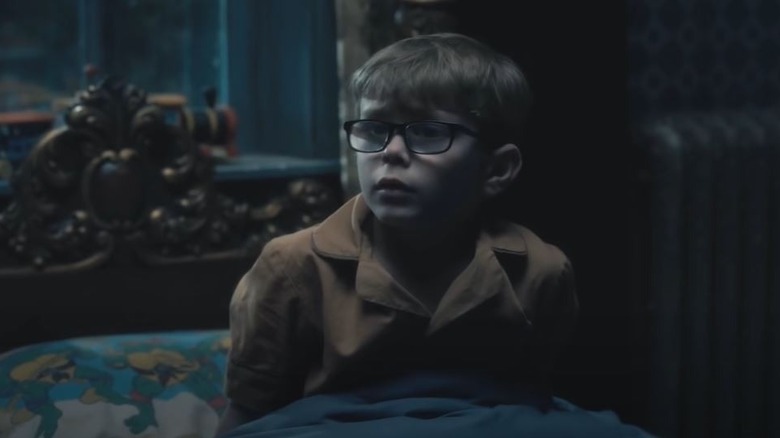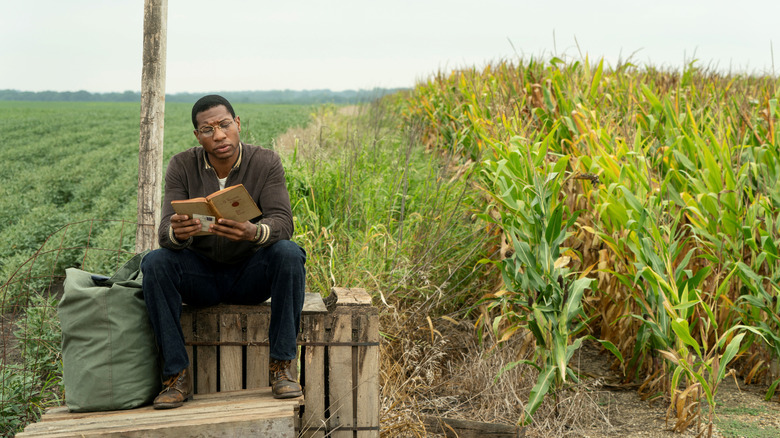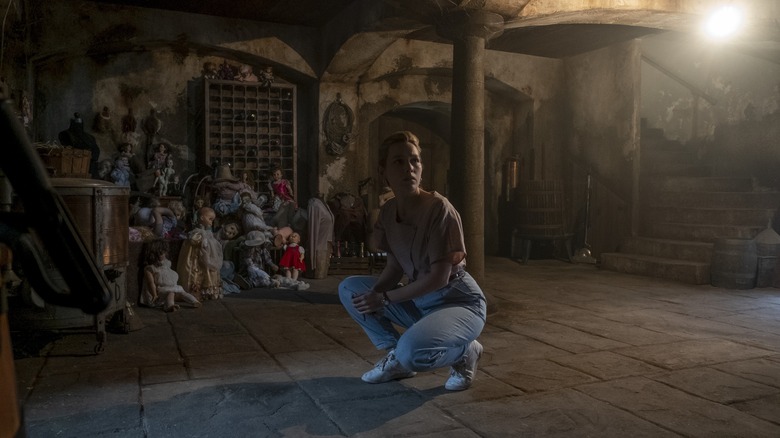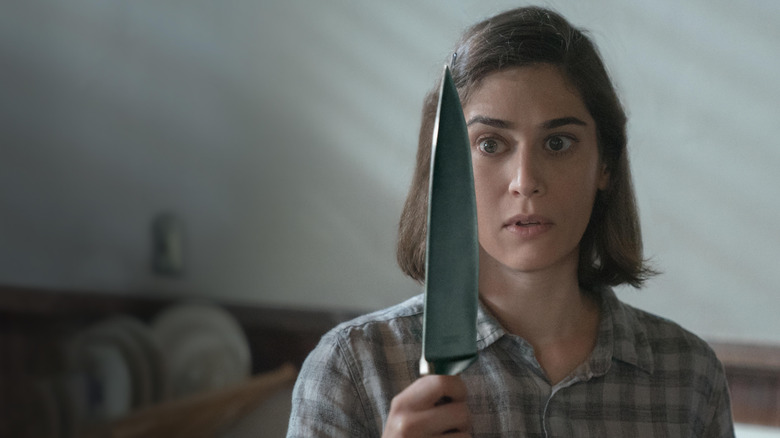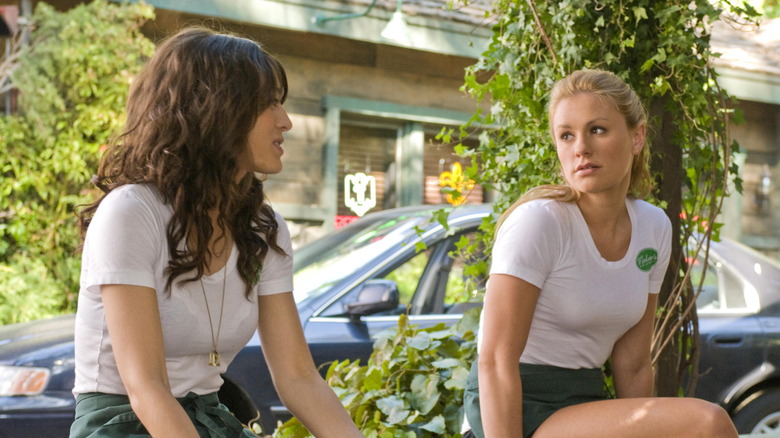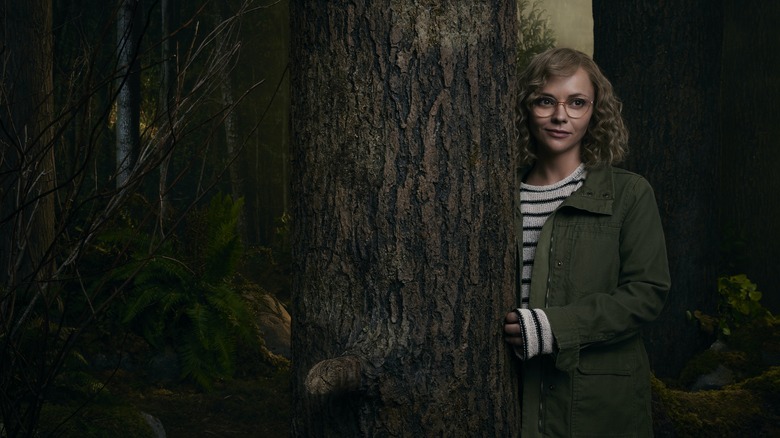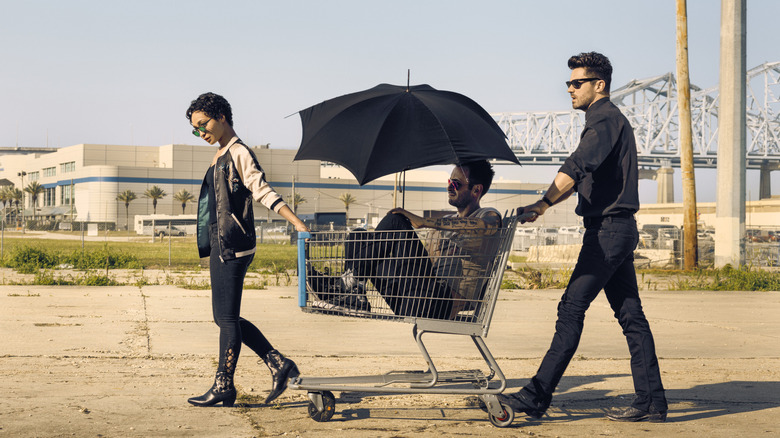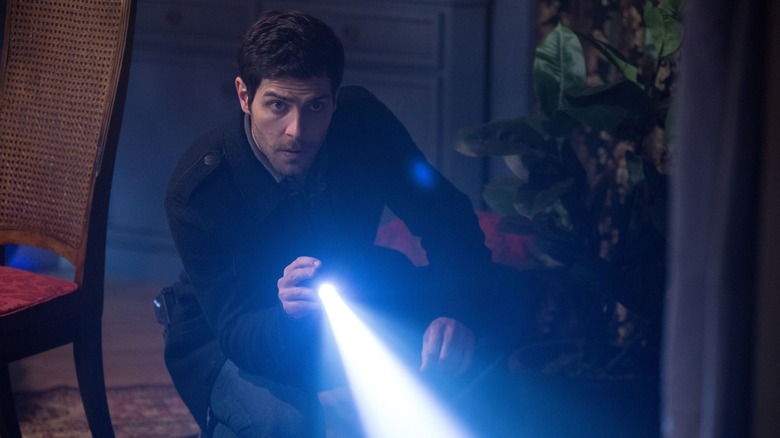The 30 Best Horror TV Shows Of All Time
Up until fairly recently, horror on television has been a tame affair. With the main networks, there was always a limitation on how far a show could go with gore or violence (although interestingly enough, police procedures have traditionally been given carte blanche to push the envelope and play up the gritty factor). As such, for the most part, things tended to be eerie or atmospheric rather than overtly scary. But with the advent of premium cable networks first and streaming platforms later, there was suddenly a lot more freedom in terms of what could be shown on camera. Sex was allowed, salty language was encouraged, and things could get spookier than ever before.
That said, it isn't as though the only good horror TV shows have come out in the past ten years — far from it. Indeed, horror and suspense have occupied a central place in American television as early as the 1950s, and have evolved over time to reflect the things that we fear most.
Haunted
Given the number of people obsessed with true crime and real-life mysteries, it seems only natural to make a show like "Haunted." It operates as a sort of pseudo-documentary, where individuals claiming to have encountered supernatural phenomenon recount their experiences for the camera. Some are more believable than others (and indeed, despite having the label of "true story" applied liberally, there are a few with very little corroborating evidence), but just like with all ghost stories, their success or failure lies in how they're told.
Rather than having the person do a traditional one-on-one confessional style interview describing their experiences, they are instead place in a room with friends and family, reminding us that these are just the latest entries in an age-old oral storytelling tradition. "Haunted" also intersperses their narrative with genuinely horrifying, gruesome reenactments that underscore the pain and trauma experienced by those who perceive themselves to be haunted.
Evil
One of the rare network shows to make the list, "Evil" does for possessions what "The X-Files" did for alien sightings. It utilizes a format similar to that groundbreaking 1990s genre show: a skeptic and a true believer forced to work together on perplexing cases that test the limits of our understanding. David Acosta (Mike Colter) is a priest-in-training who works to assess the validity of faith-based claims, such as miracles and demonic possessions. Dr. Kristen Bouchard (Katja Herbers) is a forensic psychologist tasked with separating cases of supernatural incidents from instances of mental illness. Together, the two see some things that can't easily be explained.
Recently moved from CBS to Paramount+, "Evil" continues to luxuriate in the sense of discomfort it knowingly provokes. It offers no easy answers for the terrifying visions it imparts, and challenges both its characters and the viewers to reckon with what they think they know about the universe.
Channel Zero
Honestly, the Tooth Child picture alone wins "Channel Zero" a place amongst the all-time greats of horror television. The gruesome anthology show had a successful four-season run on Syfy, bringing to life the spookiest creepypasta stories (Internet-era urban legends, many of which have gone on to widespread fame.) Each six-episode season would feature a different narrative, the first of which revolved around a horrifying child murderer whose skin was made entirely out of human teeth.
It received remarkably consistent reviews from critics for all four seasons, showing a unique ability to capitalize on simple, universal childhood fears and create memorable images that would stick with the viewer. If nothing else, you have to admire their commitment to the fear factor: although they obviously focus first-and-foremost on telling a good story, they are fearless in their efforts to bring the scariest content possible to a network not immediately known for their horror output.
Bates Motel
Norman Bates is one of the most iconic villains in all of film history, thanks largely to Anthony Perkins and his development of the character as an unhinged bird of prey. And while in the original "Psycho" we're treated to glimpses of his family life and his unhealthy relationship with his mother, it's really just enough to make us curious about his early years — before he got to the point where he's devolved to the point of conversing with skeletons in his basement. "Bates Motel" delivers the goods, giving us a tantalizing look at young Norma and Norman Bates, an eerily co-dependent duo for the ages.
A huge part of what makes "Bates Motel" work is their brilliant choice in casting. Who better to play Norman himself than Freddie Highmore, known before this as a twee child actor from films like "Charlie and the Chocolate Factory" and "Finding Neverland"? His boyish looks allowed him to appear innocent at times, and creepily malevolent at others. And of course, anytime you can get Vera Farmiga to play a wildly unstable mother, you've already won the game.
Stranger Things
An ode to 1980s adventure films with a gruesome 21st century twist, "Stranger Things" quickly became a Netflix phenomenon with just its first season. It took an ordinary suburban town and imbued it with secrets, all of which would come to a head with the sudden disappearance of a preteen boy named Will Byers. Underneath the surface of Hawkins, Indiana lies a mysterious and incredibly dangerous world called the "Upside Down," full of Lovecraftian creatures that threaten the lives of everyone they encounter. And as if that weren't enough, there's a strange girl wandering around with telekinetic powers, a shaved head, and a marked affinity for Eggos.
The most endearing aspect of "Stranger Things" is the bond that exists between the key group of friends who set out to find Will, the fourth member of their Dungeons and Dragons crew: the boys are warm, genuine, and have a natural chemistry with each other. But there's also a surprising amount of disturbing content, enough to please both the people who want 1980s "The Goonies" nostalgia and horror fans alike.
The Walking Dead
Let's get one thing out of the way first: no, "The Walking Dead" has not been the most consistent show ever to hit the airwaves. But when it was at its best, it could go toe-to-toe with any other genre show on television. Rick Grimes (Andrew Lincoln) is a deputy who wakes up in the hospital after a shooting only to discover that he's in the midst of a zombie apocalypse. He travels through the countryside and abandoned cities of the south, trying to track down his wife and young son, and along the way bands together with a group of strangers to stay alive.
The show was merciless in its zombie violence: it became clear very early on that any character could be killed off on a moment's notice. And during its first few seasons, it was constantly evolving, raising the stakes and putting its ragtag group of misfits into different scenarios. It lost its way for a little bit as it went along, but that doesn't discredit the sheer terror and heartbreak it offered us early one, when we watched characters we had grown to love die and, what's arguably worse, be forced to murder each other.
Black Mirror
A genre anthology series originally released in the UK, "Black Mirror" walks a line between science fiction and horror, reflecting the trepidation surrounding modern technology that would frequently create nightmare scenarios for its characters. It varies dramatically in tone: some of the episodes are almost lighthearted or bittersweet, while others are filled with the kind of existential dread that lingers in your mind long after the show has ended. And although none of them are scary in the traditional sense of ghosts and monsters and serial killers, there are episodes that are so disturbing that they stand up against any conventional horror shows.
They make you question humanity in a way that hurts. "Black Mirror" is built as a series of fictional cautionary tales about the dangers of allowing ourselves to be too closely intertwined with technology; most versions of this would likely make audiences roll their eyes and see their fears as overly alarmist. Here, it's done so well that it makes us pause, and reconsider.
American Horror Story
"American Horror Story" is one of the most successful and longest-running horror anthology series, inspiring a number of imitators jostling for a piece of the eerie and atmospheric pie. Each season features a different storyline, set in a different, traditionally unsettling location. In the past, we've have freak shows, cults, spooky hotels, psychiatric institutions, and the year 1984 — who knows what Ryan Murphy will throw at us next.
We are introduced to a new cast of characters, although many actors have recurred over the years, playing varied roles in each new iteration of the show. Jessica Lange in particular had quite a run on "American Horror Story" — she was featured in the first four seasons of the show and ended up taking home an Emmy, Golden Globe, and Screen Actor's Guide Award for her performances. Let's not kid ourselves, not every season of "American Horror Story" is created equally. But there's enough spooky content here to make at least one or two of them worth a Halloween binge. (We recommend "Murder House" and "Asylum" for starters.)
The Twilight Zone
As far as genre television goes, "The Twilight Zone" is pretty much the granddaddy of them all. Beginning in 1959, the show quickly developed a reputation for tackling the fears of Cold War America in a way that more traditional drama was unable to address. Known for its twist endings, "The Twilight Zone" has had a massive impact on horror, science fiction, and mystery thrillers over the past several decades. (Not to mention the sheer number of times it's been riffed on or parodied throughout popular culture.)
Rod Serling, its creator, head writer, and master of ceremonies, wanted to use the allegorical nature of the show as an opportunity to tell stories about modern issues of civil rights and the Red Scare without attracting controversy. The result is a perfect blend of horror and social awareness, with aliens and monsters serving as the stand-in for ordinary human failings.
Being Human
A ghost, a vampire, and a werewolf all end up sharing a flat together, trying to reconcile their various supernatural qualities with their desire for a normal life. "Being Human" approaches the inevitable chaos with a wink to camera, one that brings a lighter tone to the existential drama. It functions as a horror comedy most of the time, with elements of the absurd to counterbalance its darker aspects, but it does have at its heart pain, loneliness, and guilt.
Aidan Turner's performance as the vampire John Mitchell taps into this the most frequently; wracked in anguish about his formerly violent antics as a traditional bloodsucker, he struggles everyday to overcome his brutal, savage urges. To make amends for his past actions, he takes on the unlikeliest of professions for a vampire: working as a cleaner at a hospital, where he would be perpetually surrounded by not just weakened humans ripe for the taking, but endless quantities of blood.
Penny Dreadful
The Victorian world was fascinated by the occult as a means of understanding the world from a scientific perspective, rather than a religious one. Strange phenomena are catalogued and held up as examples of life after death; since the Age of Enlightenment had lessened people's certainty in a Biblical heaven, something else had to take its place. So it's fitting that this era would provide not just an apt setting for a horror show, but a useful well from which to draw classic scary stories.
"Penny Dreadful" stars Eva Green as Vanessa Ives, a powerful medium who finds herself at the heart of paranormal activity. It features both original characters like her and American gunman Ethan Chandler (Josh Harnett), whose stories have been written expressly for the purposes of the show, but it also draws upon historical Gothic figures: Dr. Frankenstein, Dracula, and Dorian Gray all exist in this one literary universe.
Supernatural
Originally conceived as a monster-of-the-week teen drama, "Supernatural" is one of the purest forms of horror on television we've had in the past 20 years. Each episode, brothers Sam (Jared Padalecki) and Dean (Jensen Ackles) Winchester travel around the country confronting ghosts, demons, monsters, and other supernatural entities. As the show dragged onto later seasons, it became more arc-driven and focused on the conflict between angels, demons, and humanity. But when it began, it was just two emotionally repressed guys avoiding therapy by spending their lives salting and burning corpses.
And that is when the show was at its scariest. They tap into traditional ghost stories and monster mythology that is very difficult to watch with the lights turned off, with each episode operating almost as a standalone horror film. Gruesome imagery and jump scares combine to bring to life an entire supernatural world that is constantly in conflict with humanity, only able to find peace with the intervention of the Winchester brothers.
Are You Afraid of the Dark?
For a very specific subset of millennial children, "Are You Afraid of the Dark?" acted as their entrée into horror. Aired during Nickelodeon's Saturday Night programming (dubbed "SNICK" and aimed at a slightly older demographic than their daytime shows), it was an anthology show with a simple premise: every week, a group of teens gather in the woods to tell scary stories to one another. Each character tends to have a different approach with their narratives — Kristin, for example, liked to tell romantic, bittersweet ghost stories, while Gary's often featured magic and the iconic Sardo ("No Mister, accent on the DOH!").
But some of their stories were legitimately traumatizing. "The Tale of the Dollmaker" was deeply unsettling, with a girl slowly turning into a porcelain doll, with her skin growing pale and hands uselessly clasped together, unable to separate them. And we don't even need to talk about "The Tale of The Dead Man's Float," the grotesque corpse from which will haunt many a 90s kid until the day they die.
Buffy the Vampire Slayer
A teenage boy and girl break into an abandoned high school at night: textbook horror movie setting. We're waiting for something terrible to happen to the girl. But surprisingly, she turns around, revealing a vampiric face. She is the threat here. With that opening scene, showrunner Joss Whedon establishes that "Buffy the Vampire Slayer" will subvert expectations within the horror genre, especially along gender lines. Sarah Michelle Gellar plays the Buffy, a cheerleader turned supernatural hunter who struggles to reconcile the demands of her birthright and a typical high school experience.
Most of the time, "Buffy the Vampire Slayer" treads between horror and comedy: yes, Buffy goes off to fight monsters every night, but she's wisecracking the entire time, and some of the monsters are even kind of funny. But every once in a while, the show conjures up a truly grotesque image that reminds you of how dark the show can go when it wants to: der Kindestod from "Killed by Death," for example, or the twisted grins from the Gentlemen in "Hush."
The Haunting of Hill House
All ghost stories are sad, by definition. With few exceptions, they all begin because someone has died, and is forced to occupy the space where they once lived, unable to move on to a different plane of existence. "The Haunting of Hill House" manages to not only provide some shockingly effective jump scares that will haunt viewers (and the image of the Bent-Neck Lady is certainly going to live rent-free in all of our heads for quite some time), but captures that intense sadness that underlies the story. This is a grieving, traumatized family that has found no other way to cope with their pain than to functionally estrange themselves from one another.
The Crain family moves into a forbidding old manor house, the parents intent on renovating it for a profit. But almost immediately, all five children begin to have strange, unexplained experiences. Conversations with people that no one else can see, shadows of movement from a room that no one has a key to: the classic signs that you should move out of a house immediately. But before they can do that, tragedy strikes. And it is this overwhelming loss than defines the Crains for the rest of their lives. They are not just haunted by spirits, they are haunted by the past.
Interview with the Vampire
For a lot of Anne Rice fans, Brad Pitt and Tom Cruise were the final word on Louis and Lestat from "Interview with the Vampire." Their 1994 film won over audiences largely on the strength of their performances, especially Cruise, who delightfully plays against type. Any new adaptation of the popular vampire novel would pale in comparison — right?
Well, not necessarily! AMC's version puts a sexy new spin on the vampire saga, allowing the characters of Louis and Lestat to lose the ambiguity around their relationship, which had previously been portrayed as homoerotic but not overtly sexual. Jacob Anderson (of "Game of Thrones" fame) stars as Louis, a pimp in 1900s New Orleans who falls under the thrall of Lestat (Sam Reid), a captivating Frenchman who has ... well, let's just say that he's been around the block a few times! The show's lead actors breathe new life into the beloved vampire franchise, which updates the novel to a fresh new setting. In the process, the show created a surprise hit that is so much better than it has any right to be.
Lovecraft Country
Inspired by the author of all things unsettling and cosmically grotesque, H.P. Lovecraft, it's no surprise that "Lovecraft Country" is big on scares. The HBO series stars Jonathan Majors as Atticus Black, a young man who recently served in the Korean War. He travels with his childhood friend and potential flame, Leti (Jurnee Smollett), in an effort to track down his mysteriously absent father. On their journey through Jim Crow-era America, they encounter many horrors — both monstrous and distinctly human.
"Lovecraft Country" may not always live up to its promising central premise. However, it's bolstered by strong performances from its two charismatic leads and the show's imaginative creature designs. At its best moments, it delivers on spookiness, creating nightmarish images that are seared into the minds of audiences. Although "Lovecraft Country" only lasted for one season, it was praised by critics for its cultural relevancy. Glen Weldon of NPR wrote, "For every fun, if wildly anachronistic, element, Lovecraft Country is always careful to re-center itself on its characters, and their hemmed-in status as Black women and men in 1950s America."
Haunting of Bly Manor
Although "The Haunting of Bly Manor" doesn't quite live up to its terror-inducing predecessor ("The Haunting of Hill House," whose car jump scene is 100% nightmare fuel), it still has plenty of creepy moments to keep audiences awake at night. The story takes place in an eerie manor in England, where a young governess (Victoria Pedretti) arrives to take care of a wealthy family's two children. Before long, she begins to see strange, ghostly apparitions around the atmospheric mansion.
If you're thinking that this story sounds familiar, you're right — it's largely based on Henry James' horror novella, "The Turn of the Screw." What it may lack in generation-defining scares, it makes up for in the general sense of unease that permeates the film. If nothing else, it's a delight to see so many of the "The Haunting of Hill House" actors return to play different characters, not just Pedretti but her co-stars Oliver Jackson-Cohen, Henry Thomas, Carla Gugino, and others.
Cabinet of Curiosities
If there's a single living director on Earth best suited to make a horror anthology series, it's Guillermo del Toro. The way his mind churns out unsettling imagery sends an unparalleled chill down the spines of audiences. So when it was announced that he would be helming Netflix's horror series "Cabinet of Curiosities," my interest was piqued. Transposing traditional gothic storytelling into a modern setting, he imbues a "Twilight Zone"-style format while showcasing the unique storytelling sensibilities of his directors.
The series provides a spotlight for several genre directors, including Jennifer Kent ("The Babadook"), Ana Lily Amirpour ("A Girl Walks Home Alone At Night"), Keith Thomas ("The Vigil"), and Vincenzo Natali ("Splice"). Despite their work being standalone episodes, the stories blend together beautifully. A.A. Dowd of Chron wrote, "There's something to appreciate in all of these miniature horror films; even the most flawed of the collection get by on some cosmetic pleasure, performance, or authorial quirk."
Dark Shadows
While it may now be hard to imagine, there was a time when soap operas reigned supreme in network programming. They ran for decades, amassing devoted fans in housewives who never missed a daily episode of their "stories." Soap operas often took place among the rich and privileged, whose outlandish behavior became perfect fodder for melodramatic hijinks — like in "Days of Our Lives." Sometimes the melodramatic shows took place in a hospital setting, gifting viewers with endless opportunities for comas, car accidents, and surprise plastic surgery reveals.
But when "Dark Shadows" debuted in 1966, the series changed the game. ABC's gothic soap opera revolved around the wealthy but eccentric Collins family and its vampiric patriarch, Barnabas (Jonathan Frid). Moody and atmospheric (and extremely campy), "Dark Shadows" embraced the supernatural and won over audiences — including the all-powerful demographic of teenage girls – and cemented its legacy in television history.
The Outer Limits
Inspired in part by "The Twilight Zone," which began four years earlier, "The Outer Limits" was another anthology series that told a different scintillating story each week. It focused its attention squarely on science fiction, taking full advantage of both the public obsession with the Space Race and the fear of the unknown that came along with it.
Although it might have seemed like an attempt to capitalize on the success of "The Twilight Zone," it became a massively influential science fiction series. Not only are several of its creature designs featured in "Star Trek," but it also generated a popular revival series in the mid-1990s. Although there have been several attempts at rebooting the series — with director Scott Derrickson allegedly attached to a big screen adaptation and Variety reporting a premium cable reimagining in 2019 — we've yet to glimpse of what a 21st-century "The Outer Limits" might look like.
The Living and the Dead
What's that, you say? Colin Morgan in a gothic horror story? We're there with bells on!
"The Living and the Dead" stars Morgan as Nathan Appleby, a doctor working in Victorian-era London — a time when modern psychiatry was still in its infancy. He is a man of science and a force of modernity, hardly a believer in the supernatural. But when his mother dies and he and his wife move back to the family estate in Somerset, he finds a traditional community full of superstition. The longer he spends time there, the more he begins to experience things that verge on the paranormal. Is there a rational explanation for all of this? Or does he have something to fear?
"The Living and the Dead" is a classic gothic tale, with enough atmosphere to fill a haunted manor. While bolstered by compelling performances from its lead cast, Morgan and Charlotte Spencer are standout performers — making the show a must-see creepy series.
In the Flesh
There's a dehumanizing quality to most zombie films and television series: As soon as someone bites a character, they stop being viewed as a person. We wait for them to turn into rabid monsters. But "In the Flesh" is one of the few series that focuses on zombiism as something other than a permanent state of being. The series poses an interesting question: What would happen if a zombie could be cured of their taste for human flesh? Would humanity welcome them back? How would they cope with the crippling guilt over their past actions?
"In the Flesh" stars Luke Newberry as Kieren Walker, a teenager from Yorkshire who rose from the dead after dying by suicide. He returns to his hometown rehabilitated but is guilt-ridden and uncertain of his place in the world. Although outwardly horror-oriented with teeth-gnashing zombies, "In the Flesh" has as much to do with the fear and prejudice of humanity.
If you or anyone you know is having suicidal thoughts, please call the National Suicide Prevention Lifeline by dialing 988 or by calling 1-800-273-TALK (8255).
The Terror
Designed to be a horror anthology series akin to "American Horror Story" — where each season tells a different, unrelated narrative from its predecessor — "The Terror" sets its sights on the Great White North. Set in the 1800s, it tells the story of two ships attempting to find a way through the Northwest Passage. But when their ships become trapped in ice and their sailors are stranded in freezing temperatures with limited supplies, things take a dramatic turn for the worse.
Based on a 2007 novel by Dan Simmons, "The Terror" features a top-tier cast, including Jared Harris, Tobias Menzies, and Ciaran Hinds. A major success for AMC, "The Terror" received critical praise, with Adam Sweeting of The Arts Desk writing: "The Terror gets its teeth into you with its gritty and unpleasantly plausible depiction of shipboard life in the mid-19th century." The series was quickly renewed for a second season — although that storyline takes place a century later at a Japanese internment camp during World War II.
Castle Rock
With the sheer breadth of Stephen King's horror catalog, it should come as no surprise that he could fill an entire town with the heroes and villains from his novels. That's pretty much what "Castle Rock" does. Set in a fictional town in King's beloved Maine, it's the closest to a horror multiverse that we've seen so far. "Castle Rock" features some familiar characters and settings, including Lizzy Caplan as Annie Wilkes, a figure made famous by Kathy Bates in "Misery."
A spooky little community with malevolence oozing out of every corner, it combines the work that King is best known for with elements of a traditional crime drama. With a powerhouse cast that includes Melanie Lynskey, Bill Skarsgard, Andre Holland, and Sissy Spacek, "Castle Rock" is just as much as focused on character-oriented storytelling as it is about bumps in the night. Although the show only lasted on Hulu for two seasons, it quickly won over King enthusiasts and general audiences alike.
True Blood
Vampire stories are always (at least a little bit) about repressed sexuality, as the seductive and otherworldly creature offers an outlet for lust and desire. But "True Blood" is raunchy, even by vampire standards. The HBO series stars Anna Paquin as Sookie Stackhouse, an ordinary Southern waitress (except for the fact that she can read minds) who — surprise, surprise — falls in love with a vampire (played by Stephen Moyer, Paquin's real-life husband).
But this isn't the typical depiction of vampires — creatures who lurk in the darkness harboring a terrible secret. "True Blood" takes place in a universe where the existence of vampires is well-known amongst the public, thanks to a synthetic blood substitute that allows them to kick their feasting-on-the-blood-of-innocents habit. If nothing else, it's famous for shooting Alexander Skarsgard, who played Viking vampire Eric Northman, into superstardom. Considered by many to be the ultimate HBO guilty pleasure show, "True Blood" has nonetheless grown into a genre staple.
Yellowjackets
When you think about horror shows, they usually focus on ghosts, ghouls, and things that go bump in the night. But what's scarier than the dark side of human nature? "Yellowjackets" revolves around the teenage players on a girls' soccer team who survive a plane crash. But they're stranded in the middle of the Canadian wilderness. While there, their survival efforts lead them to some genuinely disturbing places. The show cuts back and forth between the girls and their future selves attempting to recover from the trauma of past events.
"Yellowjackets" was met with immediate acclaim, earning seven Emmy nominations in 2021, including one for outstanding drama series and acting nods for Melanie Lynskey and Christina Ricci. Supremely popular with audiences, it was renewed for a third season before the second season aired — a rare win for genre television in an era where many networks and streaming services are growing increasingly stingy with renewals.
Preacher
Based on a comic book series by Garth Ennis and Steve Dillon, "Preacher" brings a punk rock edge to the demon-hunting business. Dominic Cooper stars as Jesse Custer, a traveling pastor who just so happens to be occasionally possessed by an all-powerful being called Genesis. Along Custer's journey to track down God, his ex-girlfriend (Ruth Negga) and an Irish vampire (Joe Gilgun) join him on his adventures.
"Preacher" became a cult favorite on AMC, running for four seasons and capturing a playfully iconoclastic spirit unique to the realm of supernatural shows. It was praised by critics for its strong performances, clever (if perverse) dialogue, and creative storytelling style. Joanne Ostrow of the Denver Post wrote: "Scripture and subtle wit are sprinkled through the outrageous violence and a particularly lovely vocal accompanies a grotesquely violent massacre aboard an airplane. This one will delight a certain narrow audience. You know who you are."
Servant
Apple TV+ may not have a huge roster of shows, but it definitely prioritizes quality over quantity. Case in point: the M. Night Shyamalan-produced thriller "Servant." Not only does it find a use for Rupert Grint's unique but considerable talents as an actor, but it takes a horrifying high-concept premise and keeps it interesting for four seasons. Season 1 begins in the wake of a tragedy: A young woman serves as a nanny for a couple's reborn doll (a hyper-realistic toy infant) after their actual son died of heat stroke in their family car.
A creepy enough premise, yes? Maybe unsettling, but what about a spooky twist? Well, this is M. Night Shyamalan we're talking about, and he has several reveals in store for you. This young woman also happens to have some not-insignificant supernatural powers. Although perhaps not especially well-known — by virtue of being an Apple TV+ program that isn't "Ted Lasso," which seems to get all the network's attention — "Servant" has gradually won over audiences who have taken the time to seek it out.
Grimm
In the proud tradition of "Buffy the Vampire Slayer" and "Supernatural," "Grimm" features an ordinary man who finds himself chosen by fate to fight against the forces of darkness. Part supernatural drama and part police procedural, the NBC show stars David Giuntoli as Nick Burkhardt, a cop who also happens to be the latest in a long line of Grimms. His lineage has a hereditary responsibility to battle with the Wesen. Who are they? Imagine every single fairy tale monster brought to life and you'll get a rough idea of what's in store for viewers.
A popular Friday night staple, "Grimm" ran for six seasons. Sadly, it was only acknowledged by the Emmys for its stunt work. Nevertheless, it developed a devoted fan following, with many critics getting on board over the course of the series run. Ken Turner of Entertainment Weekly praised the show, saying it "reinterprets its classic fairy tales with vigor, some wit, and a sleek visual flair."



